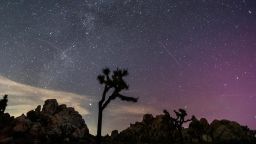Leonid Meteor Shower Peaks This Week: Viewing Guide and Tips

This week, sky-gazers around the globe have the opportunity to witness the annual Leonid meteor shower as it reaches its peak on November 20, 2023. According to EarthSky, the most favorable viewing times are expected late Sunday night and early Monday morning, with the shower peaking at 1 p.m. ET on Monday. While meteors will start to appear as early as 11 p.m. local time on Sunday, the best chances for sightings will occur between 4 a.m. and sunrise local time on Monday.
Viewing Conditions and Expectations
Robert Lunsford, fireball report coordinator for the American Meteor Society, emphasizes that the Leonids provide a unique viewing experience due to their sharp peak. “Unlike many meteor showers, the Leonids have a very sharp peak,” he explained, indicating that there is typically just one excellent night for observation. The parent comet of this meteor shower, 55P/Tempel-Tuttle, contributes to this brief duration, as Earth only passes through its small debris trail for a limited time.
Viewers are likely to see “Earth grazers” around 11 p.m. on Sunday. These meteors travel across a larger section of the sky and last longer than typical meteors. However, Lunsford notes that their numbers may be limited as much of the Leonid activity occurs away from the horizon.
Under optimal conditions, enthusiasts can expect to see between 10 to 15 meteors per hour. While this year’s meteor shower is anticipated to be modest, the Leonids are historically known for producing spectacular meteor storms. These storms can result in rates exceeding 1,000 meteors per hour, with the most recent storm occurring in 2002.
Historical Context and Future Events
The Leonids gained legendary status during the 1966 storm, when observers reported meteors falling at a rate of up to 40 meteors per second. The intense activity of that year was attributed to Earth’s passage through the center of one of the Leonid streams, creating a breathtaking display that resembled rain cascading from the sky.
The frequency of these remarkable displays is linked to the comet’s orbit, which takes approximately 33 years to complete a full revolution around the sun. For a meteor storm to occur, Earth must pass through a dense part of the comet’s debris trail during perihelion, which is its closest approach to the sun. Unfortunately, sometimes the planet only grazes the outskirts of the debris, leading to less spectacular meteor showers.
The next significant event in the Leonid cycle will occur in 2033, although Lunsford anticipates it will not reach storm levels. “We may see rates of around 100 meteors per hour, which is comparable to the Geminids,” he stated, “but we certainly don’t expect any storms with rates of 1,000 meteors per hour.”
As the Leonid meteor shower unfolds this week, sky enthusiasts are encouraged to find a dark location with clear skies for optimal viewing. With the right conditions, this celestial event promises to deliver a stunning display of nature’s wonders.






